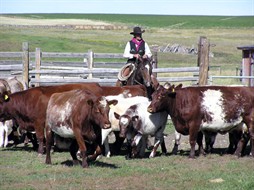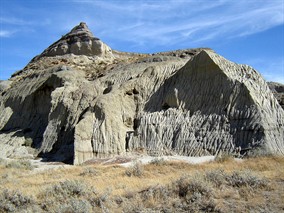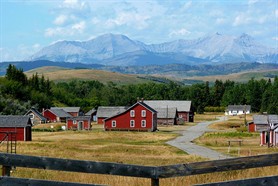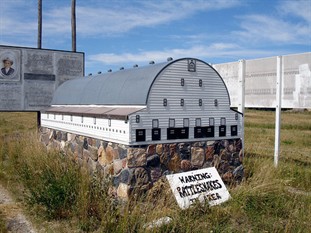Canadian Cowboy Folklore
The legends of the Wild West era are often associated with
American history; however, Canada also boasts a fascinating past
filled with legendary folklore and the colourful characters that
make these stories come to life. Western Canada is home to many
captivating historic places to commemorate this unique era of
outlaws, cowboys and the booming Canadian ranching industry. 
Back in the days of the Wild West when horse stealin' and cattle
rustlin' were a cowboy's way of life, "sometimes you'd get, and
sometimes you'd get got". The Wild West and its legendary folklore
are glorified in American History, often leaving Canada's role and
involvement overlooked. However, some of history's most notorious
Western characters dominating these popular legends, made a name
for themselves in Canada's Old West as well. The history of
Canada's West would not be complete without including the era of
horse and cattle thieves and outlaws hiding in the foothills of
south western Canada.
Notorious Canadian and American bandits such as Sam Kelly, Dutch
Henry and the legendary Nelson Jones Gang took refuge in the Big
Muddy Valley in south western Saskatchewan. This secluded area
filled with caves, gullies and bluffs proved to be an ideal place
for evading the law. The Western Canadian ranching industry
was also strongly impacted by the presence of these outlaws, with
some of Canada's most famous ranches sharing this colourful
history.
During the later part of the 19th century, Canadian
cowboy Sam Kelly was one of the most dangerous and wanted outlaws
in the West. Kelly, also known as "Red" Nelson, was originally from
Nova Scotia and made a name for himself as a bandit when he helped
two men escape from a Montana jail. Kelly was apparently in cahoots
with the town's sheriff who had led all of the town's men and
horses on a wild goose chase to locate Kelly. While they were gone,
Kelly broke into the jail and fled with the sheriff's two
prisoners, allegedly tipping his hat to the sheriff's wife on his
way out. Kelly earned himself a reputation and, alongside legendary
American outlaw Frank Jones, eventually became known as the
co-leader of the notorious Nelson Jones Gang. This dangerous gang
was the reason for increased North-West Mounted Police patrol in
the Big Muddy. The presence of law enforcement, however, didn't
stop the gang from stealing, killing, looting and then retreating
to the foothills and caves of the Big Muddy to evade justice.
 The Sam Kelly Sites in Happy Valley, Saskatchewan
comprise the caves in the Big Muddy Valley, where, according to
legend, Sam Kelly and his Nelson Jones Gang hid from American
authorities. The tall bluffs and shallow gullies of the Big Muddy
Valley proved to be an ideal place for Sam Kelly and his gang to
hide out. The tall peaks allowed the bandits to see when
authorities were on their trail, giving them enough time to escape.
The Big Muddy Valley and the Sam Kelly Caves became a stop on
American outlaw, Butch Cassidy's, infamous Outlaw Trail which
connected various hideouts and stations starting in south western
Saskatchewan and snaking down through the United States to Mexico.
Sam Kelly and his Nelson Jones Gang became experts on exploiting
these caves, designating a cave for his men and another for their
horses. It's even claimed that Kelly returned to live in his famous
caves for a few years later in his life. After a career as one of
the most lucrative outlaws of the Wild West, Kelly turned himself
in to local authorities but, conveniently, there wasn't enough
evidence to convict Kelly of a single crime. He then started a new
life and began a legitimate ranch in Debden, Saskatchewan along
with a few of his pals. The legend of Sam Kelly lives on in the
town of Debden, as well as in Canadian folklore - visit these
legendary caves and discover the life of an outlaw for yourself!
The Sam Kelly Sites in Happy Valley, Saskatchewan
comprise the caves in the Big Muddy Valley, where, according to
legend, Sam Kelly and his Nelson Jones Gang hid from American
authorities. The tall bluffs and shallow gullies of the Big Muddy
Valley proved to be an ideal place for Sam Kelly and his gang to
hide out. The tall peaks allowed the bandits to see when
authorities were on their trail, giving them enough time to escape.
The Big Muddy Valley and the Sam Kelly Caves became a stop on
American outlaw, Butch Cassidy's, infamous Outlaw Trail which
connected various hideouts and stations starting in south western
Saskatchewan and snaking down through the United States to Mexico.
Sam Kelly and his Nelson Jones Gang became experts on exploiting
these caves, designating a cave for his men and another for their
horses. It's even claimed that Kelly returned to live in his famous
caves for a few years later in his life. After a career as one of
the most lucrative outlaws of the Wild West, Kelly turned himself
in to local authorities but, conveniently, there wasn't enough
evidence to convict Kelly of a single crime. He then started a new
life and began a legitimate ranch in Debden, Saskatchewan along
with a few of his pals. The legend of Sam Kelly lives on in the
town of Debden, as well as in Canadian folklore - visit these
legendary caves and discover the life of an outlaw for yourself!

The Sam Kelly Sites are also associated with the homestead of
another famous Western character: rodeo trick rider and singing
cowboy Monty Montana. Inducted into the ProRodeo Hall of Fame in
1994, Monty Montana appeared in over 60 Tournament of Roses Parades
in Pasadena, California and was quickly recognized by fans for his
famous silver saddle. Monty Montana was a fixture of the Rodeo
Circuit in both Canada and the United States and even appeared in
various John Wayne western films. The remains of the homestead
belonging to this legendary singing cowboy are located on the Sam
Kelly Sites, making it a fascinating part of Canada's Western
history.
Another notorious bandit associated with Canada was Henry Borne,
or Dutch Henry. Known as an expert cattle rustler and the head of
an extremely powerful horse-stealing ring with up to 300 members,
Dutch Henry caused such a stir that demands for his arrest became
constant, forcing him to escape authorities and retreat to Canada.
Dutch Henry left his illegal horse ring in the U.S. and began a
career in Canada's booming ranching industry, becoming a ranch hand
in the Big Muddy Valley for respected rancher Pascal Bonneau. After
earning Bonneau's trust, Dutch Henry eventually reverted to his
criminal roots, turning against his employer and stealing his herd
of horses. Dutch Henry left his mark on Western Canada's ranching
industry and his legend lives on as one of the most notorious
bandits of the Wild West.
 The ranching industry in Canada's West
flourished in the 1880s as Parliament established the grazing lease
policy, a leasing system that supported ranchers. As a result, many
ranches flourished during this time including Bar U Ranch, established in 1882. Now a
National Historic Site, Bar U has remained a successful, working
cattle ranch which is now open to the public. Settled among the
rolling Porcupine Hills at the foot of the Rocky Mountains in
Alberta, Bar U Ranch was one of the first and largest corporate
ranches of the West. Infamous American bandit, Harry Longabaugh,
better known as the "Sundance Kid," gained ranching experience at
the Ranch before returning to the U.S. and becoming a
partner-in-crime to Butch Cassidy. Alberta's Old West ranching
industry is certainly filled with intriguing characters!
The ranching industry in Canada's West
flourished in the 1880s as Parliament established the grazing lease
policy, a leasing system that supported ranchers. As a result, many
ranches flourished during this time including Bar U Ranch, established in 1882. Now a
National Historic Site, Bar U has remained a successful, working
cattle ranch which is now open to the public. Settled among the
rolling Porcupine Hills at the foot of the Rocky Mountains in
Alberta, Bar U Ranch was one of the first and largest corporate
ranches of the West. Infamous American bandit, Harry Longabaugh,
better known as the "Sundance Kid," gained ranching experience at
the Ranch before returning to the U.S. and becoming a
partner-in-crime to Butch Cassidy. Alberta's Old West ranching
industry is certainly filled with intriguing characters!
Saskatchewan also has a very interesting and rich history
associated with the ranching industry. In fact, the remains of one
of the largest ranching barns ever built in North America are found
at the Smith Barn Site, a historic place located in
southwest Saskatchewan at the fork of the Red Deer and South
Saskatchewan rivers. Smith Barn Site refers to the foundation
remains of a large barn demolished in 1921. The enormous barn was
built by prosperous rancher, W.T.  "Horseshoe" Smith, in 1914. Before
this, Smith had operated in Great Falls, Montana, along the
American-Canadian border where outlaws and bandits on either side
engaged in stealing and selling horses. Away from the international
border and this illegal activity, Smith's massive barn and the vast
acreage of his ranch made it one of the largest operations in the
country.
"Horseshoe" Smith, in 1914. Before
this, Smith had operated in Great Falls, Montana, along the
American-Canadian border where outlaws and bandits on either side
engaged in stealing and selling horses. Away from the international
border and this illegal activity, Smith's massive barn and the vast
acreage of his ranch made it one of the largest operations in the
country.
The Canadian Wild West hasn't received the same legendary status
as its American counterpart, however, many of North America's most
legendary bandits also left their mark north of the border. The
steep cliffs, mysterious caves, and shallow gullies of the Big
Muddy Valley provided the perfect hiding spot for outlaws such as
Sam Kelly, Dutch Henry and the Nelson Jones Gang. It is no wonder,
then, that it earned its place on Butch Cassidy's Outlaw Trail.
Western Canada's cowboy and ranching industry played a significant
role in shaping Canada's history and the legends of the Old West's
most notorious outlaws are still alive today.